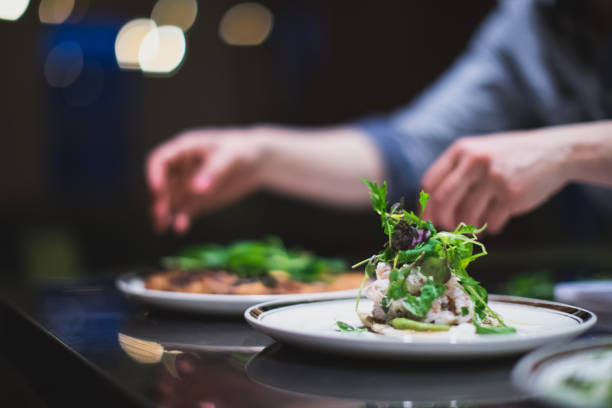Culinary Alchemy: Transforming Humble Ingredients into Gourmet Delights
Embark on a gastronomic journey that turns ordinary ingredients into extraordinary dishes. Discover the art of culinary alchemy, where simple staples become the building blocks of gourmet creations. From elevating pantry essentials to mastering flavor-enhancing techniques, this guide will unlock your inner kitchen magician.

Vegetables: From Side Dish to Star
Vegetables often play second fiddle to proteins, but with the right techniques, they can take center stage in gourmet dishes. Roasting is a game-changer for bringing out the natural sweetness and depth of flavor in vegetables. Try roasting cauliflower florets until golden brown and caramelized, then toss them with spicy harissa paste, toasted pine nuts, and a sprinkle of fresh mint for a Moroccan-inspired side dish. Transform humble carrots into a show-stopping main course by slow-roasting them with honey and thyme, then serving them atop a creamy labneh spread with a dusting of dukkah spice mix. Even everyday lettuce can become extraordinary when grilled briefly to add a smoky char, then drizzled with a tangy vinaigrette and crumbled blue cheese. By treating vegetables with the same care and attention as proteins, you’ll create dishes that are both visually stunning and packed with flavor.
Aromatics: The Foundation of Flavor
The secret to turning simple ingredients into gourmet masterpieces often lies in the careful use of aromatics. These flavor-packed ingredients form the foundation of many cuisines and can elevate even the most basic dishes. Start by mastering the French mirepoix, a blend of diced onions, carrots, and celery that forms the base of countless soups, stews, and sauces. Experiment with the Italian soffritto, which adds garlic to the mix, or the Spanish sofrito, which incorporates tomatoes and bell peppers. In Asian cuisines, aromatics like ginger, garlic, and scallions are often quickly stir-fried to release their flavors before adding other ingredients. By understanding how to use these aromatic bases, you can create layers of flavor that transform simple ingredients into complex, gourmet dishes.
Technique Matters: Mastering Culinary Methods
The difference between a good dish and a great one often comes down to technique. Mastering a few key culinary methods can help you elevate even the simplest ingredients to gourmet status. Perfect the art of pan-searing to create a crispy, golden crust on proteins while keeping the interior tender and juicy. Learn the secrets of deglazing, using wine or stock to scrape up the flavorful bits left in the pan after cooking meat, creating an instant sauce packed with depth and complexity. Experiment with sous vide cooking to achieve precise temperature control and perfectly cooked proteins every time. Even simple techniques like properly seasoning throughout the cooking process and finishing dishes with a splash of acid can make a world of difference in the final flavor profile. By honing these techniques, you’ll be able to transform humble ingredients into restaurant-worthy dishes with ease.
The Power of Presentation
In the world of gourmet cuisine, presentation is just as important as flavor. Even the simplest dishes can be elevated to fine dining status with attention to plating and garnishing. Start by thinking about color contrasts and textures when composing your plate. Use vibrant vegetable purees as a base for proteins, or create height by stacking components. Experiment with different plating styles, from rustic family-style presentations to precise, architectural arrangements. Don’t forget the power of garnishes – a sprinkle of fresh herbs, a drizzle of high-quality olive oil, or a dusting of flavored salt can add both visual appeal and a burst of flavor. Even the choice of serving vessel can elevate a dish, so consider using unique plates, bowls, or even slate tiles to showcase your culinary creations. By paying attention to these final touches, you’ll transform your home-cooked meals into Instagram-worthy gourmet experiences.
Culinary Alchemy: Tips and Tricks
• Invest in a few high-quality ingredients like truffle oil or aged balsamic vinegar to add instant gourmet flair to simple dishes.
• Master the art of seasoning by tasting and adjusting throughout the cooking process, not just at the end.
• Experiment with unexpected flavor combinations, like pairing fruit with savory dishes or adding a touch of sweetness to balance spicy foods.
• Learn to make your own compound butters, flavored oils, and spice blends to add unique twists to everyday ingredients.
• Don’t underestimate the power of texture – add crunch with toasted nuts or seeds, or create contrast with crispy elements against creamy bases.
• Embrace imperfection in your plating for a more natural, artistic look that’s both elegant and approachable.
In conclusion, culinary alchemy is about more than just following recipes – it’s about understanding ingredients, mastering techniques, and letting your creativity shine. By applying these principles to everyday cooking, you can transform humble ingredients into gourmet delights that rival those found in high-end restaurants. Remember, the true magic of cooking lies in experimentation and personal expression, so don’t be afraid to put your own spin on these ideas. With practice and passion, you’ll soon be creating culinary gold in your own kitchen.




